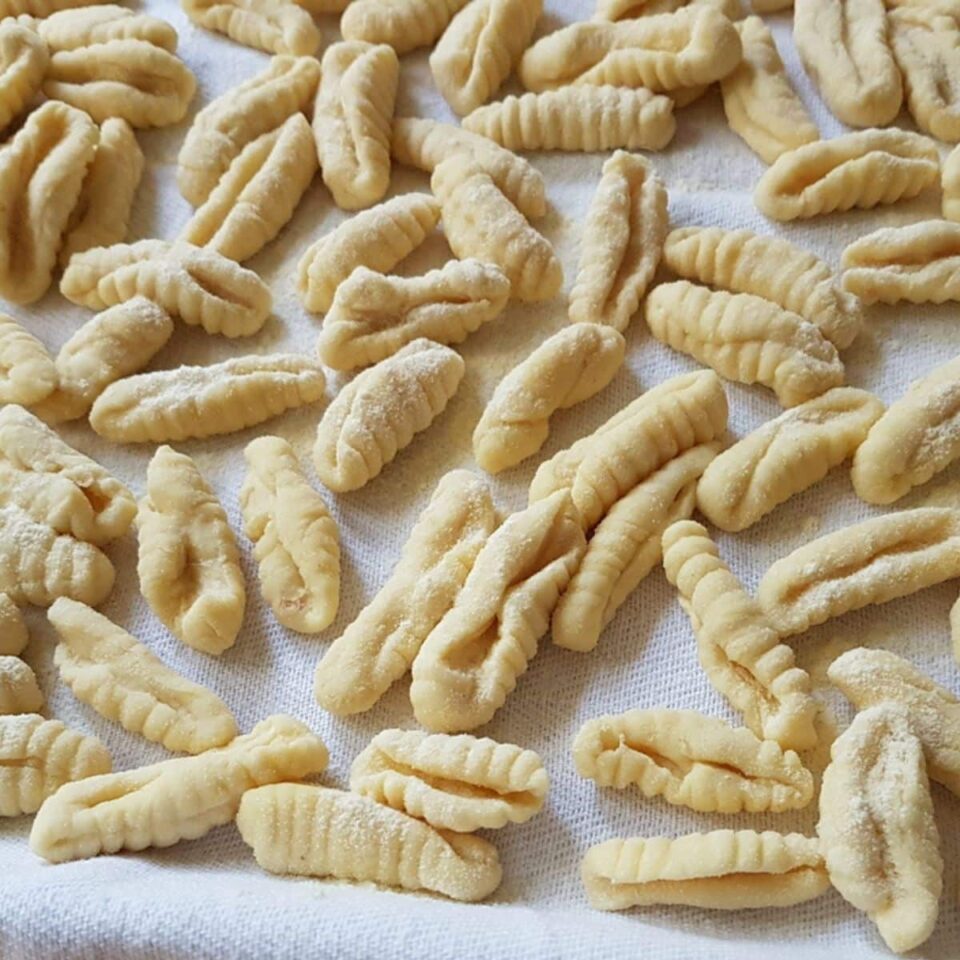
What is Cavatelli?
Cavatelli are a small shell of pasta made from durum wheat semolina flour and originates from Molise and Puglia. However, this pasta is also widespread throughout Southern Italy and is today traditional in Abruzzo, Campania, Basilicata, Calabria and Sicily. Each of these regions has its own typical cavatelli recipes.
The word cavatelli actually means ‘small cables’. It comes from the Italian ‘cavo’ or ‘incavo’ meaning hollow or indentation. The closest English word would be cavity!


Different sizes of cavatelli.
Classic cavatelli from Puglia and Molise are traditionally made by rolling the dough into long ropes or snakes and then cutting them into 5cm long pieces. The cavatelli are then formed by pressing the three middle fingers of one hand into each piece of dough to create a cavity.
However, in some areas of Southern Italy, cavatelli are shortened using only the index and middle fingers or just the index finger. Calabrian cavatelli, called ‘cavateddhi’ in the local dialect, are made using only the index finger.
In some places, people stretch the pieces of dough even further by doubling the length of the “string” to about 10 centimeters. Then they use the 3 middle fingers of both hands.
Cavatelli are traditionally smooth, smooth. However, there are those who prefer it with ridges or grooves (striped), like the malloreddus. To make pasta this way you will need a wooden cutting board, similar to a gnocchi cutting board. Nowadays it is also common to see people making cavatelli using a knife or a machine.
History and tradition
Cavatelli are traditionally served with different ingredients from region to region. In Molise, the original homeland of cavatelli, this pasta has always been an important part of family Sunday menus.


On Sundays and other special days, cavatelli are often served with a hearty pork sausage ragu, a thick sauce made from pork chops, sausages and tomatoes. This dish is a staple, loved for its rich flavors and connection to the region’s culinary heritage.
There is also a legend that in the old days, the bride-to-be’s mother-in-law would inspect her fingertips to see if they looked worn and a little worn. This was the telltale sign that she knew how to make cavatelli and therefore she would be an excellent wife!
ingredients
Fresh and dried cavatelli typically have only three ingredients: durum wheat flour, salt and water. However, sometimes extra virgin olive oil is added to the fresh cavatelli dough for a slightly richer flavor.


Some recipes also use two types of flour; Type ’00’ soft wheat flour combined with semolina flour called ‘re-milled durum wheat semolina’ (indicating that it has been ground twice for fineness).
Preparation
To prepare your cavatelli follow these steps or take a look at my recipe for homemade cavatelli.
Mix the dough: Start by pouring the flour into a bowl and mixing with the salt. Create a fountain in the center and pour the water. Gradually mix the water into the surrounding flour, incorporating all the flour and water until you can turn the dough out onto a kneading surface.


Knead: Knead the dough, adding more water if it is too dry or a little more flour if it is too sticky, trying to obtain a consistency similar to plasticine. Continue kneading for 5-10 minutes until the dough is smooth and non-sticky. Let it rest, covered or wrapped in cling film, for 15-30 minutes.


Modeling: Sprinkle semolina flour onto two rimmed baking sheets. Divide the dough into 8 pieces. Keeping the rest covered, roll a piece of dough into a long rope, about 8mm in diameter, then cut it into 2cm long pieces.
Using the tip of your index and middle fingers, press each piece firmly and pull the dough towards you so that it stretches slightly and forms a curl in the center. If using a gnocchi board, roll the pieces along the board to add ridges.


Cooking tips
Water preparation: Start by bringing a large pot of water to a vigorous boil. Add a generous amount of salt and wait for the water to boil again before adding the pasta.
Fresh Cavatelli: The size of the cavatelli can affect the cooking time, but a reliable sign that they are almost cooked is when they start to float to the surface. Sometimes, they may require an extra minute in the boiling water after floating.
Dried Cavatelli: Dried cavatelli generally require more time to cook. Be sure to stir them occasionally to prevent sticking and ensure even cooking. Start checking the cooking a minute before the recommended time on the package to make sure they have the perfect “al dente” consistency.


Serving
Cavatelli’s unique shape makes it incredibly versatile and perfect for a wide range of sauces and ingredients. Here are some classic combinations:
- With Meat Sauces: Its shape is well suited to hearty meat ragùs such as this traditional Molise pork sausage ragù, as it can easily capture pieces of meat.
- Vegetable-based sauces: For a lighter but still traditional option, top the cavatelli with sautéed vegetables like turnip greens or a simple tomato and basil sauce.
- Seafood dishes: In coastal regions, Italians often pair cavatelli with fish sauces, incorporating ingredients such as mussels or clams.
More Cavatelli Recipes:
Frequent questions
Absolutely! While a cavatelli cutting board or gnocchi board adds ridges, you can also use a fork to create the distinctive cavatelli shape. It will take a little longer but will also give enough consistency for the sauce to stick together.
Yes, fresh cavatelli freezes well. Spread the dough onto a baking sheet to freeze individually, then transfer to a freezer bag. You can cook your cavatelli directly from frozen, adding a minute or two to the cooking time.
Yes, the cooking time of cavatelli can vary depending on their size. Generally, longer cavatelli pieces will take a little longer to cook than shorter pieces. However, the principle for testing whether they are cooked is always the same: when they start to float on the surface of the boiling water, it is a good time to start testing them because they are most likely ready.
Conclusion
Cavatelli are a fascinating pasta that has a rich history in Southern Italy. Native to the Molise and Puglia regions, its distinctive shape and texture have made it a favorite in various Italian regions, from Abruzzo to Sicily.
While fresh cavatelli might be easily available in Southern Italy, the dried version of this pasta is gradually gaining popularity beyond Italy’s borders. You are increasingly likely to find dried cavatelli in online stores or Italian specialty shops around the world.
Preparing cavatelli at home is surprisingly simple and very rewarding: it’s worth trying! I’m sure that by serving homemade cavatelli you will amaze your guests, offering them a taste of authentic Southern Italian cuisine right in your dining room.
Pin for later:


If you are interested in learning how to make homemade pasta and different types of gnocchi, check out my shop page for some great online video courses taught by my friends in Rome! There’s nothing better than learning how to make pasta from Italians! Also, while you’re at it, why not order a copy of one of my pasta recipe books or check out some recommended pasta making tools?
If you found this article interesting or useful, please let us know with a comment here on the blog or at The Pasta Project Facebook page.
Looking forward to hearing from you.

